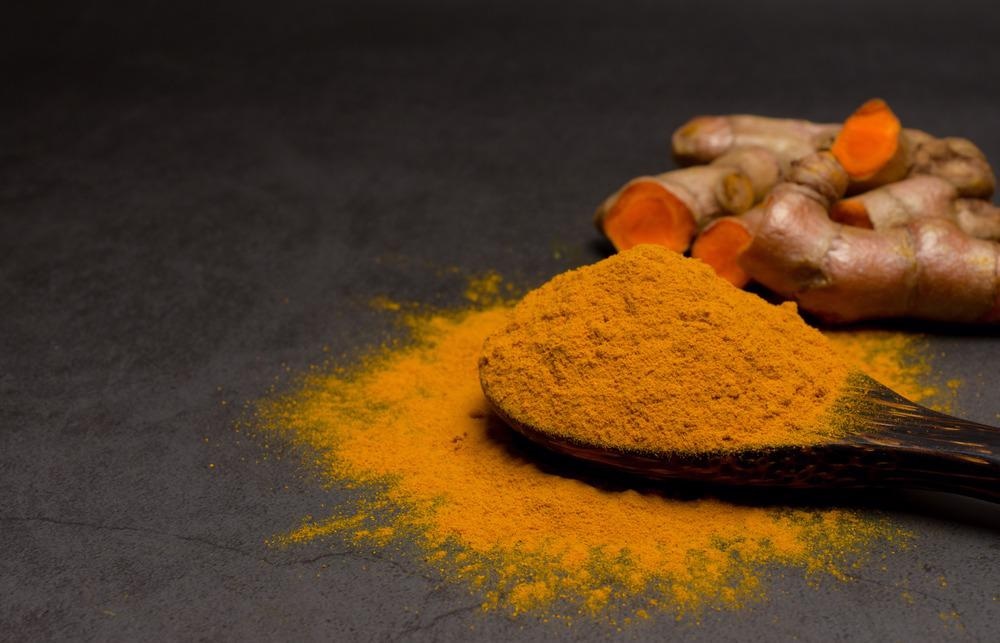In a recent study published in the journal Dyes and Pigments, researchers from Brazil developed metal complexes of curcumin dyes with a potential application in photodynamic therapy for skin treatment.

Study: Synthesis and photophysical properties of metal complexes of curcumin dyes: Solvatochromism, acidochromism, and photoactivity. Image Credit: Natthapol Siridech/Shutterstock.com
Metal Complexes of Curcumin Dye for Photodynamic Therapy
Curcumin (1,7-bis(4-hydroxy-3-methoxyphenyl)-1,6-heptadiene-3,5-dione) is a natural pigment often known as turmeric, widely used as a spice and medical ingredient in India. Curcumin has antioxidant and wound healing properties, anti-inflammatory capabilities, low dark toxicity, and its derivatives also have excellent electrical and optical properties due to the highly symmetric structure of delocalized electrons.
Metal complexes of curcumin dyes are used for two purposes: cell imaging using fluorescence properties and cell damage caused by visible light irradiation. Curcumin and its derivatives may benefit from metal chelation because it reduces their tendency to hydrolyze in aqueous media, resulting in increased stability, bioavailability, and therapeutic efficacy.
Curcumin complexes are far more effective than pure curcumin since they are both biologically stable and active.
Photodynamic therapy (PDT) is a non-invasive and promising method for treating many skin diseases by applying a harmless photosensitizer (PS). Although curcumin has been recognized as a PS for application in PDT, it has some limitations such as low in vivo stability, easy photodegradability, bioavailability, absorbance at short wavelength, and low singlet oxygen quantum yield.
The researchers prepared and studied the effect of metal complexation on the N, N-diethylamine curcumin dye for use in PDT.
Methodology
Metal complexes of curcumin dyes were synthesized by chelation of curcumin dye with the metals Cu (II) and Pd(II). The procedure was divided into two steps: synthesis of the curcumin ligand and synthesis of metal complexes of curcumin dyes, both of which were prepared by researchers using previously published methods with slight modifications.
The curcumin dye was prepared by charging ethyl acetate, acetylacetone, and boric anhydride into a two-neck round-bottom flask, followed by the addition of 4-diethylaminobenzaldehyde and tributyl borate at room temperature. Further, the reaction mixture was stirred before adding n-butylamine in ethyl acetate dropwise over 15 minutes and again stirred for 4 hours at 80 °C.
The metal complexes of curcumin dye were synthesized using CuCl2 or PdCl2 in1,10-phenanthroline in CHCl3, and the suspension was filtered, and the solid was washed with CHCl3 after stirring for 24 hours at room temperature. As a result, Cu(phen)cur-NEt2 – dark red powder and Pd(phen)cur-NEt2 – brown powder were developed.
Results
The photophysical properties of curcumin dyes in different solvents were investigated using ultraviolet-visible spectroscopy (UV-visible) spectroscopy with time-resolved or steady-state fluorescence techniques. According to the findings, all curcumin dyes exhibited positive solvatochromism from non-polar to polar solvents, with Stokes' shifts ranging from 1895 to 4970 cm-1, which is significant for PDT applications.
Acidochromism studies were conducted in chloroform solution and TLC plates containing trifluoroacetic acid (TFA). The results showed a negative acidochromism and fluorescence quenching with the gradual addition of TFA, demonstrating reversibility.
The ICT system (D-p-A-p-D structure) is the primary mechanism that influences solvatochromism, and fluorescence lifetime decays exhibited a mono-exponential fit for aprotic solvents and a bi-exponential fit for protic solvents (EtOH and MeOH). The metal complexes, (Cu(phen)cur-NEt2 and Pd(phen)cur-NEt2) also had higher singlet oxygen quantum yields than the curcumin ligand.
Further Reading - Food-Derived Paint: The Sustainable Future of Color?
Six different microorganisms were used to evaluate the in vitro antimicrobial photoactivity. The results showed that the metal complexes exhibited both antifungal activities and antileishmanial properties, and the ligand showed no activity.
Conclusions
In this study, the curcumin ligand was developed by the condensation reaction of acetylacetone with 4-N, N diethylaminobenzaldeyde, and the curcumin complexes (Cu(phen)cur-NEt2, Pd(phen)cur-NEt2) were obtained by the chelation of dichloro(phen)metal(II) with the ligand.
Further, the researchers conducted a detailed study of the photophysical properties of curcumin dyes in different solvents. The bi-exponential fit obtained indicates that LE and CT species coexist. The addition of TFA, the negative acidochromism, and fluorescence quenching was observed in the study, and chelation of Cu (II) and Pd (II) did not significantly influence the absorption/emission. The tests against six different microorganisms showed the promising potential of metal complexes of curcumin in PDT application.
Disclaimer: The views expressed here are those of the author expressed in their private capacity and do not necessarily represent the views of AZoM.com Limited T/A AZoNetwork the owner and operator of this website. This disclaimer forms part of the Terms and conditions of use of this website.
Source:
de França BM, Oliveira SSC, Souza LOP, Mello ThaíP, Santos AndréLS, Bello Forero JosuéS. Synthesis and photophysical properties of metal complexes of curcumin dyes: Solvatochromism, acidochromism, and photoactivity, Dyes and Pigments (2022), https://www.sciencedirect.com/science/article/abs/pii/S0143720821008779?via%3Dihub